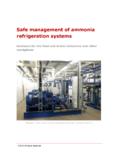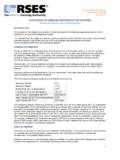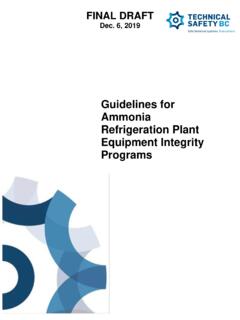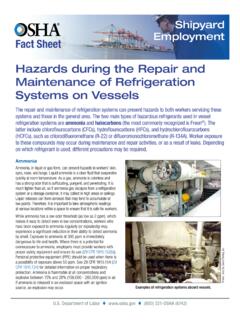Transcription of 4. How Much Ammonia is Too Much? Part 2
1 4. How much Ammonia is Too much ? part 2 This material was produced under grant SH-19489-SH9 from the Occupational Safety and Health Administration, Department of Labor. It does not necessarily reflect the views or policies of the Department of Labor, nor does mention of trade names, commercial products, or organizations imply endorsement by the Government. OSHA sets limits for the amount of chemicals workers can be exposed to during their work shift. OSHA has the power to enforce these limits. The Permissible Exposure Limit for Ammonia set by OSHA is 50 parts per million (ppm) averaged over an eight hour work day. This is the standard that must be met in every work place. For example, this means you can be exposed to 100 ppm for 4 hours of your shift as long as you are not exposed to any Ammonia for the other 4 hours of your work day.
2 Any other combination that averages out to 50 ppm would also be acceptable to OSHA. NIOSH is the government agency that makes recommendations to OSHA. NIOSH reviews the available science to figure out a safe exposure limit for most workers over the course of a working lifetime. The NIOSH Recommended Exposure Limit (REL) for Ammonia is 25 ppm averaged over an eight-hour work day. NIOSH also says that there should be a Short Term Exposure Limit (STEL) of 35 ppm during any 15 minute period in the day. No worker should be exposed to more than that amount over any 15 minute period. NIOSH recommendations are not enforceable. Companies can choose to follow them, but they don t have to. Questions for discussion: 1. A refrigeration Tech is exposed to 100 ppm of Ammonia for an hour while he repairs a leaky valve. For the rest of the shift he is working on the roof and is not exposed to any Ammonia .
3 Has he exceeded the OSHA PEL? Has he exceeded the NIOSH REL? Has he exceeded the NIOSH STEL? 2. Plants with Ammonia refrigeration systems often set their sensors to alarm when they detect Ammonia at 25 ppm. Why? (Hint: Ammonia refrigeration systems are supposed to be closed systems)
















